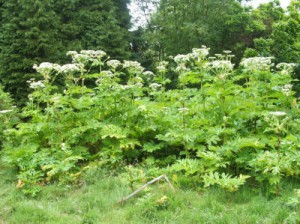 Giant Hogweed, or Heracleum mantegazzianum is a white flowering plant in the carrot family, which looks similar to a very large hemlock. It is also known as ‘hogsbane’, ‘giant cow parsnip’ or ‘cartwheel flower’. It was introduced to Britain by the Victorians as an ornamental plant, and is now widespread throughout the British Isles, especially along riverbanks. How Can I Identify Giant Hogweed? Giant Hogweed usually grows to 2-5m, but may be larger. It looks similar to Cow Parsley and Hemlock.
Giant Hogweed, or Heracleum mantegazzianum is a white flowering plant in the carrot family, which looks similar to a very large hemlock. It is also known as ‘hogsbane’, ‘giant cow parsnip’ or ‘cartwheel flower’. It was introduced to Britain by the Victorians as an ornamental plant, and is now widespread throughout the British Isles, especially along riverbanks. How Can I Identify Giant Hogweed? Giant Hogweed usually grows to 2-5m, but may be larger. It looks similar to Cow Parsley and Hemlock.
- The stem is green, with a lot of purple dots on, and obvious coarse white hair. Stems can be 2-4inches thick.
- It has small white umbrella clustered flowers, which all face upwards, clusters can be as big as 60cm diameter.
- Leaves are large.
- Here is a useful guide to the plant
Why is Giant Hogweed a problem to horses? Giant hogweed causes photosensitization. This means that ingesting the plant or skin contact with the sap can cause severe skin irritation when exposed to UV light (such as sunlight). The horse is unable to fully metabolise the plant when it is eaten, and so compounds which react to light are deposited throughout the body. When exposed to UV light, these compounds react, releasing harmful free radicals that literally burn the tissue, which becomes blistered and can split, leaving open wounds. Eyes can also suffer, and horses may be left with cloudiness or even permanent scaring that could cause blindness.  It can take a long time for the skin to recover, and animals can be left with permanent scaring. Secondary skin infections due to open wounds are not uncommon. In extreme cases the tissue damage can be so bad that the animal needs to be euthanised. What to do if you suspect your horse has eaten/been in contact with Giant Hogweed:
It can take a long time for the skin to recover, and animals can be left with permanent scaring. Secondary skin infections due to open wounds are not uncommon. In extreme cases the tissue damage can be so bad that the animal needs to be euthanised. What to do if you suspect your horse has eaten/been in contact with Giant Hogweed:
- Immediately call your vet
- If any plant matter is in the horse's month, using protective gloves remove this and thoroughly wash the mouth
- Bring the horse out of sunlight
Once in recovery, keep the horse out of sunlight and allow grazing at night. Keep open wounds clean, and avoid insects getting near them . Feeding a soothing skin supplement rich in omega-3 rich supplement, such as Feedmark’s EquiDermis Plus can help with inflammation and encourage healthy new skin growth. Please note: this plant is equally as damaging to humans and companion animals. If you think you have Giant Hogweed on your land fence it off, and get expert advice on removal.











